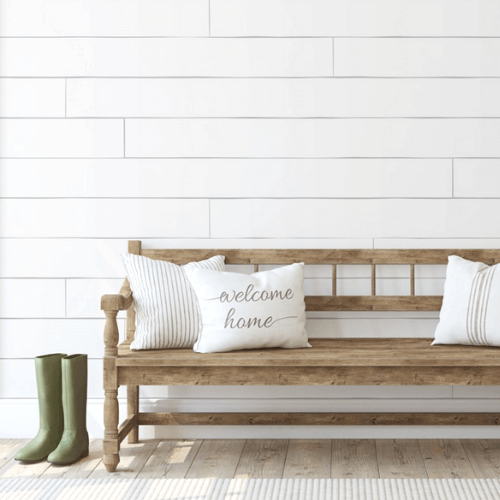Bench Staining Project with Sage Phillips
Narrow benches are typically listed between $400-$900! CRAZY right?! I’m going to show you how to make one with just one piece of affordable lumber!
For This Project You'll Need:
| 2 x 8 x 8’ knotty pine | Minwax stain |
| Hammer | Reciprocating saw (optional) |
| Saw | Rags |
| Sander | Wood glue |
| Sandpaper | Dirt |
| Chisel | Screws |
| Wire brush | Matte polyurethane |
Cutting the wood
Cutting the wood
Using my mitre saw I cut my lumbar in half to give me two 4’ pieces. Set one aside as it will be used for the top of the bench. Using a table saw or circular saw cut the second piece into
4x — 17” x 2.5” pieces (legs)
2x — 4” x 2.5“ pieces (bottom support)
2x — 2.5” x 2.5” pieces (top support)
Using your mitre saw cut a 5-degree angle on all 4 legs and bottom support and top support pieces.


Aging the wood
Using my chisel and hammer I distress the wood to my liking.
Next, I took my reciprocating saw to the edges of the boards to leave some nice deep cuts and saw marks
Once I was happy with the distressing, I sanded all the pieces with 60 grit, then 80 grit and finished it off with 120 grit sandpaper.
And lastly, the true trick to aging wood… a wire brush. Go over the wood with your wire brush to scuff it up as much as possible.


Staining the bench
To achieve an aged look, I first stained the bench with Minwax’s Simply White (this helps to remove the yellow out of the wood) and using a rag I applied a coat of Minwax’s early American. Really rub the stain into the creased you created by distressing. Then, I quickly sanded everything down again (you can always skip this step, but it really helps create deeper tones in the wood to make it look aged). Next using a rag, I applied a second coat of early American, really rubbing it in. After the stain has cured for a day apply a coat of Minwax’s polyurethane.


Need help with your project? Our Project Centre team is ready to answer all your questions, no matter how big or small your project is. Consult our Project Centre today to find the perfect solutions in your dream color and budget!




